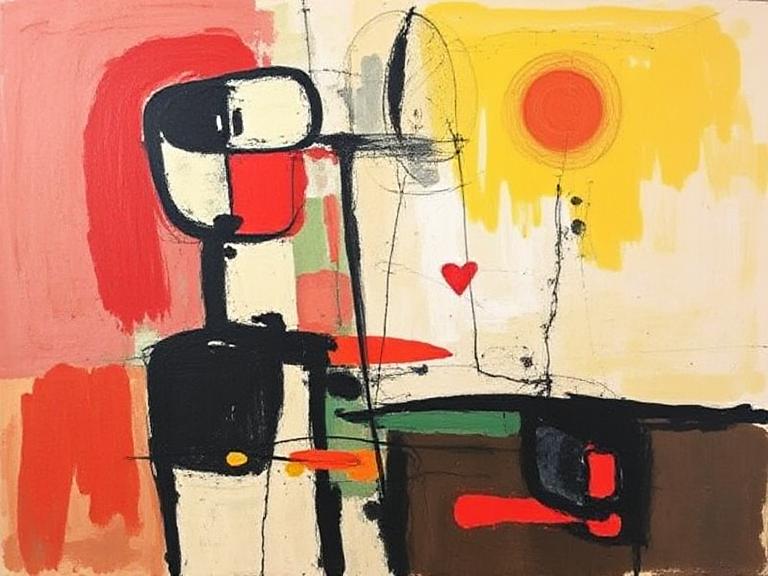Is Abstract Expressionism Modern Art?
Abstract Expressionism is a revolutionary art movement that emerged in the mid-20th century, leaving an indelible mark on the art world. While many associate the term “modern art” with the works of early 20th-century artists like Pablo Picasso or Henri Matisse, Abstract Expressionism is often seen as one of the key milestones in the journey of modern art. This article will explore whether Abstract Expressionism can truly be considered modern art and how its evolution shaped contemporary art movements.
1. What Is Abstract Expressionism?
Before we dive into whether Abstract Expressionism qualifies as modern art, it’s essential to define what the movement represents. Emerging in the 1940s and 1950s, Abstract Expressionism was a radical shift from the structured and figurative styles of earlier art movements. It prioritized personal expression, spontaneity, and emotional intensity over representational forms.
Characteristics of Abstract Expressionism
- Non-Representational Forms: One of the defining features of Abstract Expressionism is its abandonment of recognizable objects or figures. Instead, artists used colors, shapes, and brushstrokes to convey emotion and individual experience.
- Focus on Emotion: The movement sought to express the artist’s innermost feelings, often through large-scale canvases, intense colors, and dynamic brushwork. The emotional energy of the work was seen as more important than the aesthetic or formal aspects.
- Spontaneity and Freedom: Many Abstract Expressionist artists embraced a sense of freedom and spontaneity in their work, often employing techniques like drip painting, impromptu brushstrokes, and a lack of clear structure.
Prominent Artists of the Movement
Artists like Jackson Pollock, Mark Rothko, Willem de Kooning, and Franz Kline are often cited as some of the leading figures of Abstract Expressionism. Pollock’s “drip” paintings, Rothko’s color fields, and de Kooning’s chaotic brushstrokes became iconic symbols of the movement.
2. Is Abstract Expressionism Considered Modern Art?
The short answer is: yes, Abstract Expressionism is widely regarded as part of modern art. To understand why, it’s important to look at the historical context of modern art and how Abstract Expressionism fits into that timeline.
The Evolution of Modern Art
Modern art, as a general category, refers to the period of art history that began in the late 19th century and continued through the early 20th century. It includes various movements such as Impressionism, Cubism, Surrealism, and Fauvism, each of which broke away from traditional art styles. Modern artists challenged conventions and experimented with new forms, perspectives, and materials.
Abstract Expressionism came about during a time when modern art was evolving rapidly, and many artists sought new ways to express their emotional and psychological states. While movements like Cubism focused on fragmented shapes and Fauvism explored bold colors, Abstract Expressionism focused more on the raw energy and emotional power of the brushstroke itself. This shift was aligned with the ideals of modern art: breaking away from the past, embracing individualism, and pushing boundaries.
Post-War Influence
Abstract Expressionism also emerged in the aftermath of World War II, a time when artists were deeply affected by the global trauma, social upheaval, and shifting cultural landscapes. The movement reflected the internal struggles, alienation, and anxiety of the post-war generation. Its focus on the unconscious mind and emotional expression mirrored other modern movements that sought to engage with the human experience in new and dynamic ways.
Globalization of Modern Art
During the post-war period, Abstract Expressionism, especially through figures like Pollock, gained international attention and helped establish the United States as a center for modern art. This marks a key transition in the history of modern art: Abstract Expressionism became a defining movement of mid-20th-century art, reinforcing its position within the broader modern art movement.
3. The Relationship Between Abstract Expressionism and Contemporary Art
While Abstract Expressionism itself was born from modernist principles, its influence can still be felt in contemporary art. Contemporary art refers to the art being created today, and it builds upon the foundation established by movements like Abstract Expressionism.
Influence on Later Movements
Many contemporary artists draw inspiration from Abstract Expressionism, particularly its focus on emotion, abstraction, and process. Movements like Minimalism, Pop Art, and Street Art incorporated elements of Abstract Expressionism, such as large-scale canvases, bold colors, and non-traditional materials.
Artists like Jean-Michel Basquiat and David Hockney have infused their works with elements reminiscent of Abstract Expressionism, though they often combine it with other stylistic approaches. This blend of techniques and concepts exemplifies the ongoing relevance of Abstract Expressionism in contemporary art.
Abstract Expressionism’s Legacy in Art Today
The legacy of Abstract Expressionism is seen in the way modern and contemporary artists continue to value personal expression and emotional intensity. Today, artists such as Sébastien Montel, whose works explore emotional depth and abstraction, embody many of the principles that Abstract Expressionism introduced.
Through the use of abstract forms, bold colors, and dynamic compositions, Montel’s art showcases the enduring power of expression that Abstract Expressionism championed. His work highlights how abstract techniques still resonate with audiences today, making a strong case for the movement’s continued relevance in the contemporary art world. You can explore more of his abstract artworks on his official website.
4. Conclusion: The Enduring Legacy of Abstract Expressionism
In conclusion, Abstract Expressionism is firmly rooted in the tradition of modern art. The movement marked a revolutionary shift in how art was created and perceived, prioritizing emotion, spontaneity, and individualism. While it emerged in the mid-20th century, its influence is still widely felt in contemporary art.
Through its focus on the emotional expression of the artist and the breakdown of traditional artistic norms, Abstract Expressionism helped shape the landscape of modern art. As contemporary artists continue to engage with these concepts, Abstract Expressionism remains a foundational movement that continues to inspire and influence art today.

